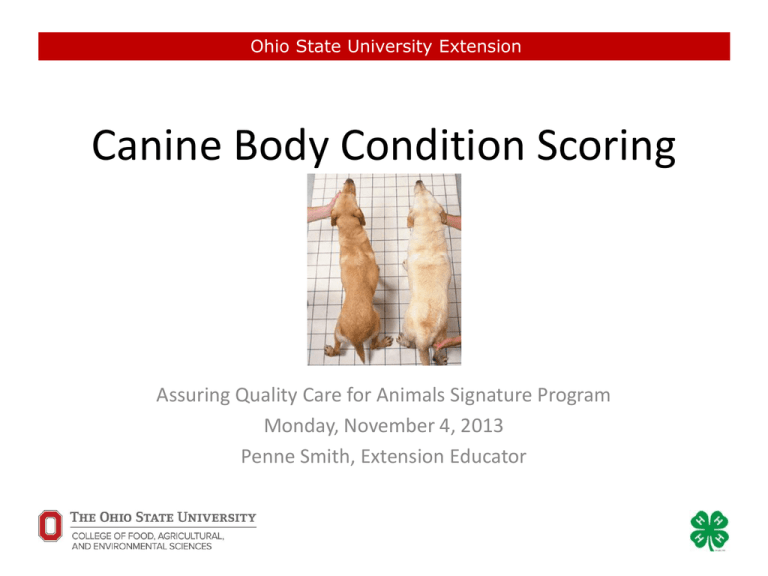Canine Body Condition Scoring - Ohio 4
advertisement

Ohio State University Extension Canine Body Condition Scoring Assuring Quality Care for Animals Signature Program Monday, November 4, 2013 Penne Smith, Extension Educator Ohio State University Extension What is body condition scoring? • Body condition scoring was developed as a way to standardize the assessment of whether animals are underweight or overweight. • It is based on a scale running from 1-5 where 1 is an emaciated animal and 5 is grossly obese. Ohio State University Extension What is body condition scoring? • The place on the scale on which the animal falls is determined by assessing several criteria. These are: • How easily are ribs felt • How obvious are the waist and abdominal tuck • How much excess fat is beneath the skin • How much muscle mass is present Ohio State University Extension Why is body condition scoring useful? • Body condition scoring allows vets and animal owners to easily share this information with one another. • It has been shown that the body condition score is related to the percentage above which dogs are overweight and consequently can be used to suggest a target weight. Ohio State University Extension Why is body condition scoring useful? • Since even within individual breeds there are a range of shapes and sizes that dogs come in, body condition score allows target weights to be tailor made rather than just suggesting the breed average. • There are a number of diseases that dogs can get where the risk or severity is worsened if the animal is obese. Body condition scoring can be used to define those animals at risk. Ohio State University Extension Why is body condition scoring useful? Ohio State University Extension 1 = Emaciated Ribs, lumbar vertebrae, pelvic bones and all body prominences evident from a distance. No discernible body fat. Obvious absence of muscle mass. Ohio State University Extension 1 = Emaciated Ohio State University Extension 2 = Thin Ribs easily palpated and may be visible with no palpable fat. Tops of lumbar vertebrae visible. Pelvic bones less prominent. Obvious waist and abdominal tuck. Ohio State University Extension 2 = Thin Ohio State University Extension 3 = Moderate Ribs palpable without excess fat covering. Abdomen tucked up when viewed form side Ohio State University Extension 3 = Moderate Ohio State University Extension 4 = Stout General fleshy appearance. Ribs palpable with difficulty. Noticeable fat deposits over lumbar spine and tail base. Abdominal tuck may be absent. Ohio State University Extension 4 = Stout Ohio State University Extension 5 = Obese Large fat deposits over chest, spine and tail base. Waist and abdominal tuck absent. Fat deposits on neck and limbs. Abdomen distended. Ohio State University Extension 5 = Obese Ohio State University Extension Rib Palpation • Place both thumbs near the backbone and spread both hands across the rib cage. • In dogs with an ideal BCS individual ribs are palpable with no excess fat covering. Ohio State University Extension Rib Palpation • In dogs with a BCS of 1/2, there is no discernible fat over the ribs. • In dogs with a BCS of 3/4, the individual ribs are difficult to palpate due to the moderate level of fat covering them. • In a dog with a BCS of 5, individual ribs are barely or not at all palpable. Ohio State University Extension Waist Palpation • Place both thumbs near the backbone and fingers right behind the last rib. • The width of the abdomen directly behind the last rib should be smaller than the width of the ribs, and should slightly increase near the pelvic region • (hour-glass appearance). Ohio State University Extension Tail-Base Area Palpation • Place the thumb on one hip bone and all other fingers except the index finger on the opposite hip bone. • Use the index finger to palpate the dorsal spinous processes of the vertebrae in the region. • Dogs with an ideal BCS should have a smooth contour in that area, but bones can be felt under a thin layer of fat. Ohio State University Extension Tail-Base Area Palpation Continued • The hip bones and dorsal spinous processes become more prominent and may actually protrude in dogs that are underweight, and may not be palpable as the dog becomes obese. • Obese dogs can also develop rolls of fat in the tail-base region that give the appearance of a dimple. Ohio State University Extension Dorsal Spinous Process Ohio State University Extension What are the signs of an overweight dog? • • • • • • • • • • Is it difficult to feel his ribs or spine? Is it difficult to see your dog's waist? Is his abdomen sagging? Does his face look more round with larger cheeks? Often appear tired and lazy? Lag behind on walks? Pant constantly? Need help getting in the car? Resist playing games? Bark without getting up? Ohio State University Extension Body Condition Scoring Ohio State University Extension Body Condition Scoring Ohio State University Extension








